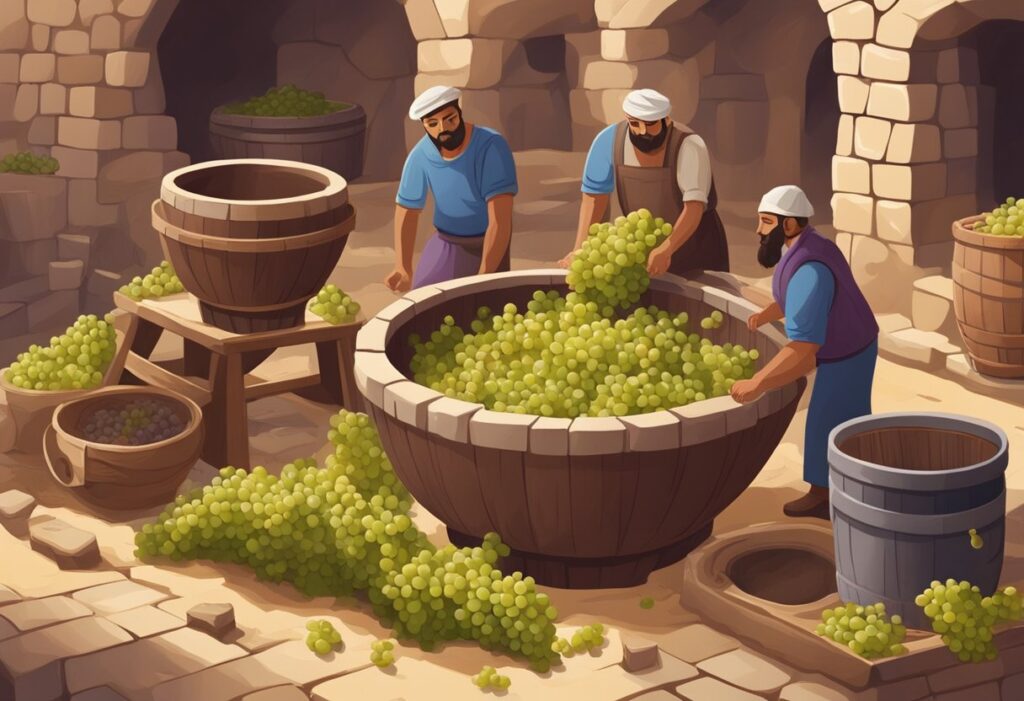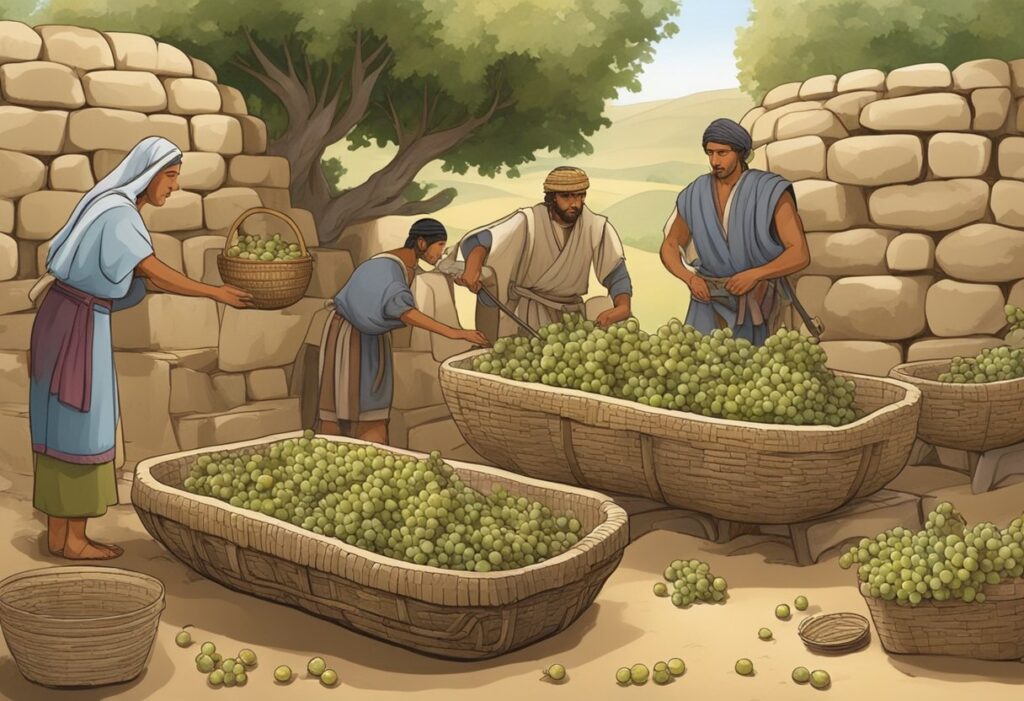Imagine stepping back thousands of years to uncover the roots of a beloved tradition: winemaking. Ancient winemaking practices started in the fertile regions between the Tigris and Euphrates rivers. People harvested grapes, crushed them with their feet, and fermented the juice in large clay vessels called amphorae. These amphorae were often sealed with clay or pitch to preserve the wine.
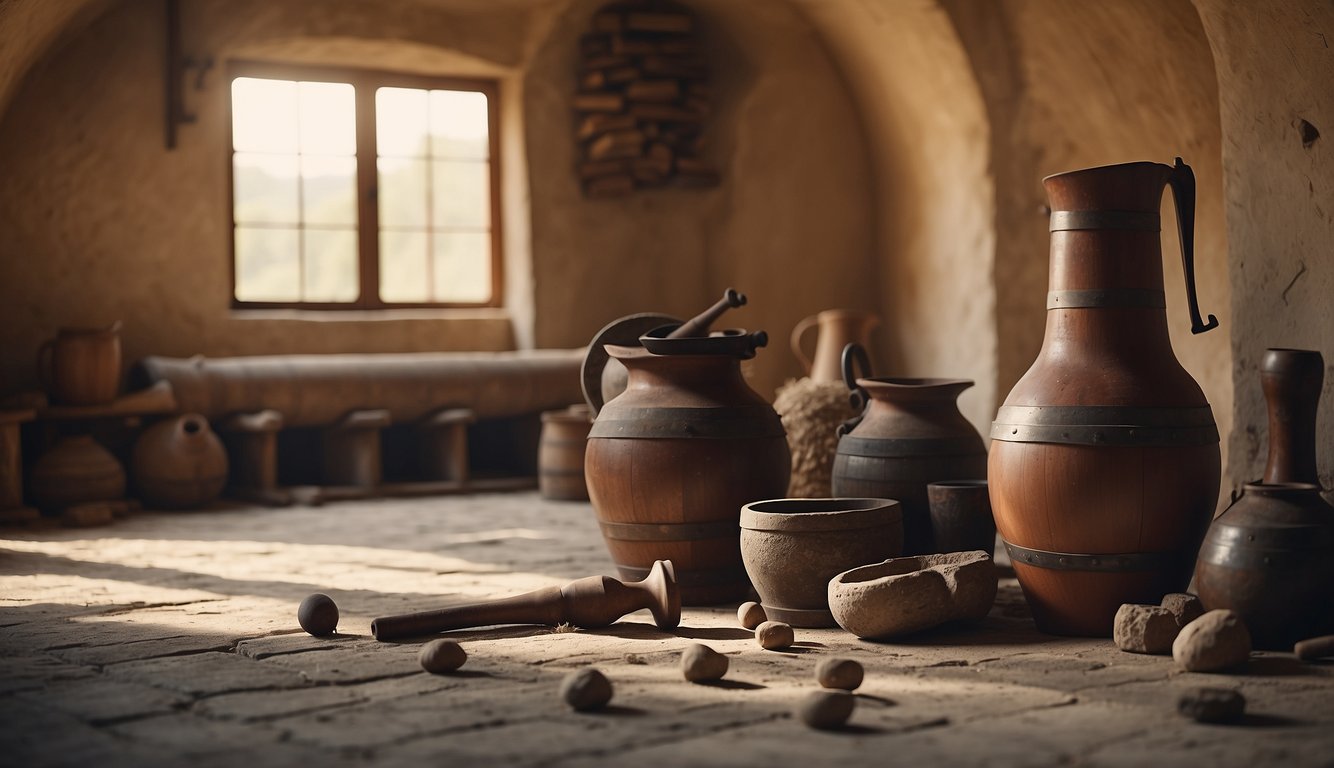
From the Sumerians and Babylonians to the ancient Near East around 6000 BCE, these ancient peoples laid the foundation for modern viticulture. The tools they used were simple but effective. Foot treading, a technique that gently crushes grapes, was a common practice that continues in some regions today. Fermenting the grape juice in earthenware jars was another technique that has stood the test of time, influencing winemaking even now.
By learning about these ancient winemaking techniques, you gain a deeper appreciation for how civilizations of the past shaped the present. Their methods and tools form a vital part of our heritage, showing how tradition and innovation can coexist beautifully in the world of wine.
Origins of Winemaking
Winemaking dates back thousands of years, with early methods shaping today’s techniques. The journey began with Neolithic communities and later expanded across various ancient civilizations.
Neolithic Innovators
The origins of winemaking can be traced back to the Neolithic Period. Around 6000 BCE, early evidence suggests that people in regions like Georgia and Iran started to cultivate grapes and produce wine. They used simple tools and methods, such as pressing grapes by hand or foot and fermenting the juice in clay vessels.
In Georgia, archaeologists have found ancient grape seeds and remnants of wine in clay pots. This points to one of the oldest known wine production sites. Similarly, in Iran, discoveries of ancient pottery with wine residues show that winemaking practices were present in early societies there as well. These early efforts laid the foundation for the sophisticated techniques that would follow.
Cradle of Viticulture
The Areni-1 Cave in Armenia is another significant archaeological site. Here, researchers discovered ancient winemaking equipment dating back to around 4000 BCE. This includes a wine press, fermentation vats, and storage jars, providing evidence of advanced winemaking practices. The findings at Areni-1 Cave highlight the role of Armenia as a crucial player in the early history of wine production.
Simultaneously, Egyptians were mastering their own techniques. They fermented grape juice in clay amphorae, which were sealed with mud or pitch to prevent spoilage. Egyptian artwork and hieroglyphs often depict grape cultivation and wine consumption, emphasizing wine’s cultural significance.
Spread to Ancient Civilizations
Greece and China also have rich histories of early winemaking. In Greece, wine became a fundamental part of daily life and religious ceremonies. Evidence from archaeological sites shows that the Greeks perfected the art of grape cultivation and domestication of Vitis Vinifera, the common grapevine.
Meanwhile, in China, ancient texts and discoveries indicate that wine made from grapes, as well as other fruits like rice and honey, was being produced around 7000 BCE. The diversity of ingredients reflects the innovative spirit of early Chinese winemakers.
These early practices not only influenced the regions where they originated but also spread across other ancient societies, shaping modern winemaking techniques. Each region contributed unique methods and tools, enriching the wine culture we know today.
The Process of Ancient Winemaking
Ancient winemaking involved several key steps including harvesting and crushing grapes, fermenting the juice, and storing the wine. Different cultures had their own specific methods and tools.
From Grape to Juice
In ancient times, the process started with the harvesting of grapes. Workers picked ripe grapes by hand. These grapes were then taken to a communal area where they were crushed. One common method involved people stomping on the grapes with their feet, which helped release the juice while avoiding damage to the seeds. The ancient Sumerians and Babylonians often used large clay vessels to hold the juice. For more details, you can read about the practices of ancient winemaking here.
Fermentation and Techniques
Once the grapes were crushed, the juice was allowed to ferment. This process was essential for turning grape juice into wine. Fermentation occurred naturally thanks to the wild yeasts present on the grape skins. The juice was often placed in a large container, such as an amphora, which could be sealed with clay or pitch to keep out air and contaminants. Different regions developed unique techniques to control fermentation. For instance, the ancient Near East had methods dating back to around 6000 BCE.
Storage and Preservation
After fermentation, storing and preserving the wine was crucial. The amphorae used for fermentation often doubled as storage vessels. Sealing these containers properly was vital to prevent spoilage. Sometimes clay stoppers or resin sealants were used. The wine might be kept in cool, dark places to maintain its quality. These practices allowed ancient civilizations to enjoy their wine year-round and even transport it over long distances. For more insights into the history of wine production and its preservation techniques, check out this resource.
Tools and Technology
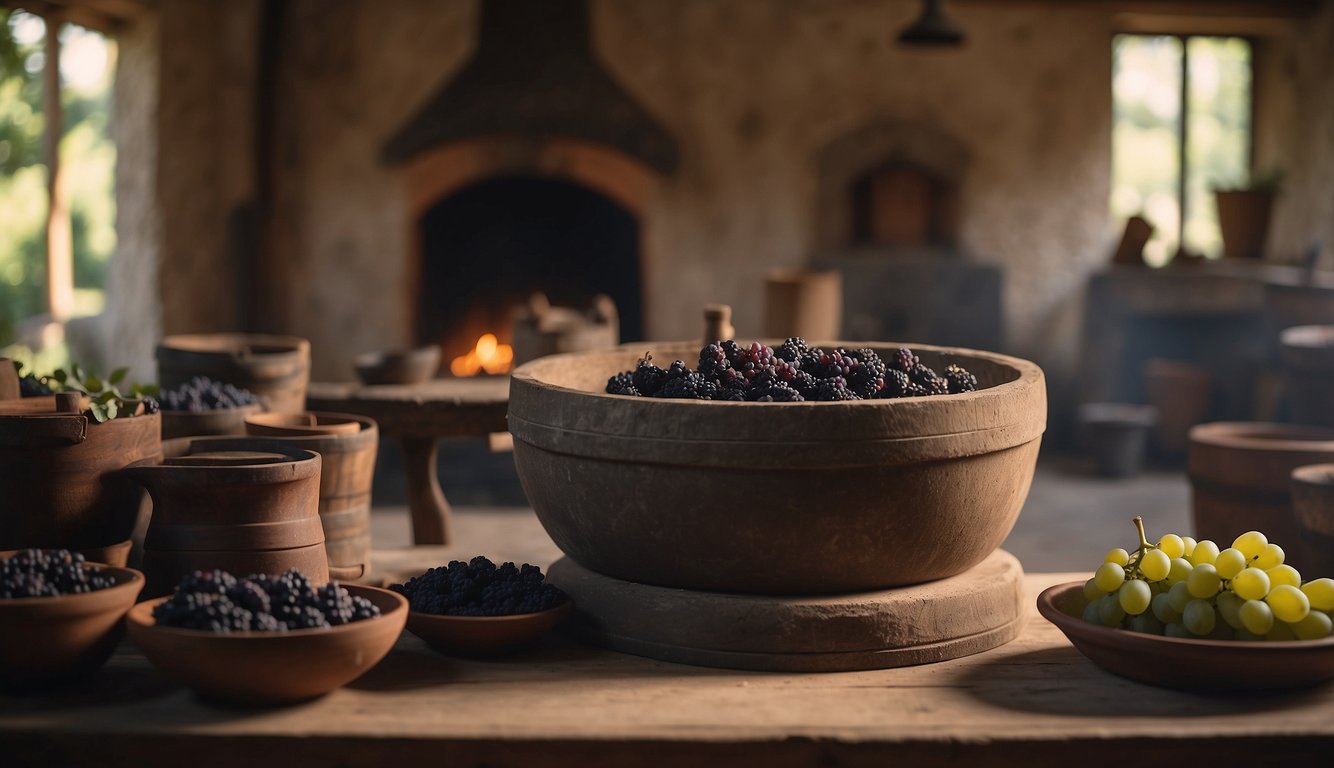
In ancient winemaking, various tools and materials were essential to produce and store wine. Understanding the specifics of these practices gives insight into the intricacies and advancements of this age-old craft.
Materials and Containers
Amphorae and Pithoi were widely used to ferment and store wine. Amphorae were large clay vessels often sealed with clay or pitch. These containers helped control the fermentation environment, preventing exposure to air.
Another important container was the Pithos, a much larger vessel that could hold greater quantities of wine. It was made of clay, similar to amphorae, but was often buried to keep the wine cool. The use of these containers highlights the ingenuity of ancient winemakers in preserving their product for extended periods.
Mechanisms of Pressing
One of the earliest methods for extracting juice from grapes was foot treading. People would crush the grapes with their feet in large vats, a process that was both simple and effective. This method is still used in some traditional winemaking practices today.
The introduction of the wine press, particularly the torcular, marked a significant advancement. This device used a screw mechanism to apply pressure and extract juice more efficiently than foot treading. Grape seeds were often separated during this process, which helped control bitterness in the final product.
Advances in Storage
Storing wine in suitable conditions was crucial for maintaining quality. Clay amphorae continued to play an essential role in aging and transporting wine. These vessels were often coated with resin or pitch to make them airtight and preserve the wine’s flavor.
As technology advanced, wooden barrels became more common. They offered better protection against spoilage and allowed wine to develop complex flavors over time. While not as old as clay containers, the use of wooden barrels represented a significant shift in winemaking technology.
By learning about these ancient tools and techniques, you gain a deeper appreciation for the heritage and innovation that shaped modern winemaking.
Cultural and Religious Significance

Wine has played a significant role in various ancient cultures, particularly in religious ceremonies and social interactions. It was often linked to gods and myths, while also aiding in commerce and trade.
Wine in Mythology and Religion
In ancient Greece, wine was deeply connected to the god Dionysus, the god of wine and festivity. The Greeks believed that drinking wine could bring them closer to this deity. They held festivals called Dionysia, filled with wine, music, and theater, honoring his influence.
In Egypt, wine was often reserved for pharaohs and used in religious ceremonies to honor gods. It was involved in rituals and often buried with the deceased to ensure they had provisions in the afterlife.
Romans also integrated wine into their religious practices. The Roman god Bacchus mirrored the Greek Dionysus, and feasts dedicated to him were common. Sacrifices and offerings were made, and wine was poured as a libation to gods during religious rituals.
Social Influence and Trade
Wine was more than just a beverage; it was a vital part of social life in the ancient Mediterranean. It played a key role in feasts and gatherings, enhancing social bonds and showcasing hospitality.
In Roman and Greek societies, wine represented status and was often used to impress guests. Fine wines were traded across the Mediterranean, forming part of a vibrant wine trade network. It facilitated economic interactions between cultures and was a sought-after commodity.
The Romans perfected techniques in vineyard management and wine production, influencing modern wine practices. Wine trade expanded the cultural exchange, as different regions shared their unique winemaking methods and flavors, enriching the overall wine culture.
Wine’s social and economic impact underpins much of Western civilization’s development, reflecting its lasting importance in our history.
Legacy in Modern Winemaking
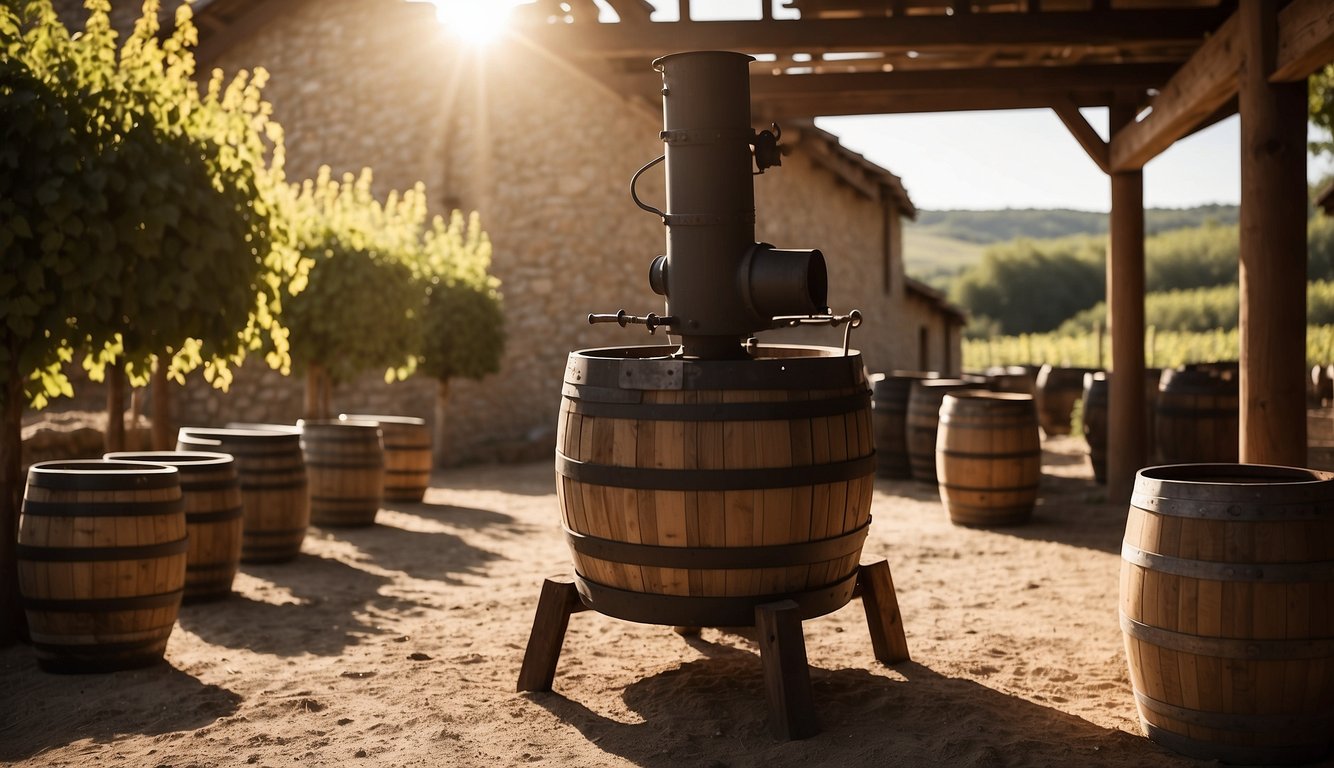
Ancient winemaking practices have greatly influenced modern viticulture. Many of the techniques used by ancient civilizations are still in use today, reflecting the cultural heritage and knowledge passed down through generations.
In California, vintners often incorporate ancient methods such as grafting, a technique used to combine the qualities of different grape varieties. This approach helps in managing disease resistance and improving the quality of the grapes.
Across Spain, many vineyards adopt ancient winemaking tools like clay amphorae. These vessels, initially used by the Sumerians and Babylonians, are now used to ferment and age wine, imparting unique flavors and characteristics based on the terroir.
Modern winemaking also utilizes ancient techniques in vineyard management. For instance, the gentle crushing of grapes by foot, a method dating back to ancient times, is sometimes used to preserve the delicate flavors of certain wine varieties. This practice highlights the blending of traditional and modern methods.
List of Ancient Techniques in Modern Winemaking:
- Foot Crushing: Preserves delicate flavors.
- Clay Amphorae: Used for fermentation and aging.
- Grafting: Combines qualities of different grape varieties.
The cultural heritage associated with ancient winemaking continues to be a significant aspect of today’s viticulture. By reviving and incorporating these time-tested practices, modern winemakers not only honor the past but also enhance the diversity and richness of their wines.
